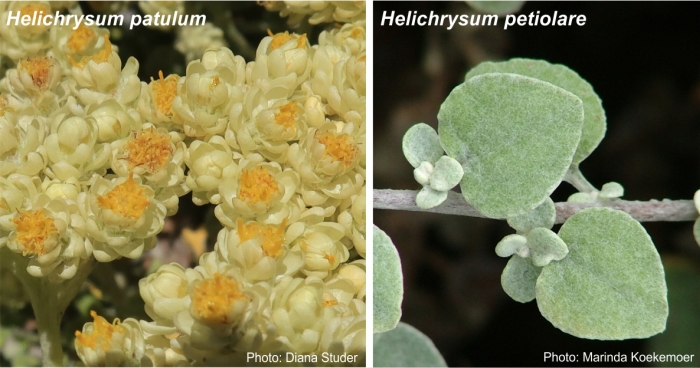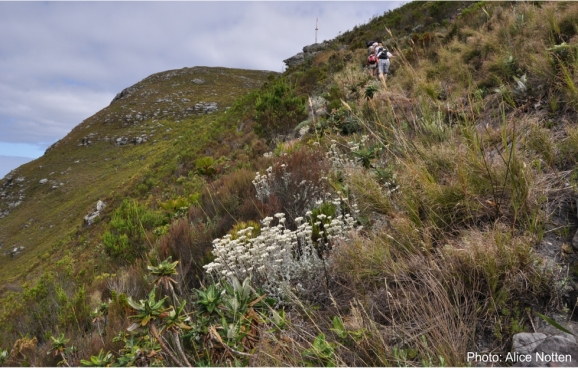Helichrysum pandurifolium
Helichrysum pandurifolium Schrank
Family: Asteraceae
Common names: fiddle everlasting; fiddle-leaved strawflower (Eng.); kooigoed (Afr.)
Introduction
Helichrysum pandurifolium is a woolly grey shrub with small clusters of gorgeous, yellow flowers surrounded by creamy white, papery bracts. It is an aromatic plant that is found in fynbos on the sandy and rocky mountain slopes of the Western Cape and Eastern Cape Provinces.

Fig. 1. Helichrysum pandurifolium showing flowers and leaves. (Photo fynbos_adventures)
Description
Description
Fiddle everlasting is an evergreen perennial shrub growing up to 1 m tall. It is spreading, with numerous, soft, leafy stems that are loosely branched and the flower heads are extended by a peduncle (stalk). The branches are noticeably long, grey and hairy or woolly. The leaves are alternately arranged, ovate (egg-shaped or oval) 8–16 x 8–10 mm, grey-woolly on both sides, margins crisped, constricted and eared at the base and clasping the stem. This species possesses a very strong aromatic odour.

Fig. 2. A typical specimen of Helichrysum pandurifolium, showing height and width when fully grown. (Photo Marinda Koekemoer)
The flower heads are campanulate (bell shaped), ± 5–8 x 6–14 mm, made up of 12–39 yellow flowers. Each flower head is enclosed by creamy white, papery involucral bracts. Few to many flower heads are presented in loose clusters at the tips of branches. Bristle pappus (tuft of hairs on the base of flower and later at the apex of fruit/seed) with open cilia cohering the bases firmly. Achenes (small, dry , thin-walled, one-seeded fruit) are up to 0.75 mm long and shaped like a barrel. It flowers from spring to midsummer (between September and January), but mainly in spring and early summer (from October to December).

Fig. 3. LEFT Alternately arranged, strongly aromatic, ovate leaves of Helichrysum pandurifolium, with grey-wool on both sides and margin crisped. (Photo Marinda Koekemoer) RIGHT A cluster of campanulate flower heads showing yellow flowers surrounded by creamy, pointed, involucral bracts. (Photo Marcus Melck)
It is similar to Helichrysum patulum and H. petiolare, however it may be differentiated by its more pointed involucral bracts.

Fig.4. LEFT Flowerheads of the closely related Helichrysum patulum. Note the rounded tips of the bracts compared to the pointed tips of Helichrysum pandurifolium. (Photo Diana Studer) RIGHT Leaves of the closely related Helichrysum petiolare. (Photo Marinda Koekemoer)
Conservation Status
Status
According to the Red List of South African Plants, Helichrysum pandurifolium is assessed as of Least Concern (LC). It is a widespread species that is not declining.
Distribution and habitat
Distribution description
Helichrysum pandurifolium is widely distributed in the Western Cape Province, from the Cape Peninsula to Bainskloof and Waboom’s River, through the coastal districts to the Tsitsikamma and Kouga Mountains in the Eastern Cape Province. It grows on hills and mountain slopes in sandy or rocky places in Fynbos and Renosterveld at altitudes of 4 to 1 590 m.

Fig.5. Typical habitat of Helichrysum pandurifolium where it grows on hills and mountain slopes in sandy or rocky places in Fynbos and Renosterveld. (Photo Marcus Melck)
Derivation of name and historical aspects
History
The name Helichrysum is derived from the Greek words helios meaning ‘sun’ and chrysos meaning ‘gold’, which is fitting given the attractive yellow flowers displayed by many species in the genus. The specific epithet pandurifolium is derived from the term panduratus/ -a/ -um (Latin), which means ‘shaped like a fiddle or violin’ and refers to the shape of the leaves.
Helichrysum pandurifolium is part of the aster family, Asteraceae. The genus Helichrysum consists of about 600 species worldwide, found in Africa, Madagascar, Australasia and Eurasia, with approximately 250 species widely distributed in South Africa and Namibia. They are known for their remarkable morphological variation. There are 30 groups recognised, based on the form and size of the flower heads, which serve as distinguishing features.
Ecology
Ecology
The flowers attract bees and other insects, which pollinate them. The seeds are light in weight, with a tuft of bristly hairs that functions as a wing and are dispersed by wind. The hairs on the leaves help prevent water loss, allowing the plants to thrive on little water.
Uses
Use
Infusions of fiddle everlasting are used to treat respiratory conditions, cough, backpain, heart trouble, kidney stones and kidney related ailments. This plant is said to be used as a demulcent since it relieves inflammation and irritation. Historically, it has also been used a herbal tea.

Fig. 6. Helichrysum pandurifolium growing in Sandstone Fynbos on Constantiaberg, Cape Peninsula. (Photo Alice Notten)
Growing Helichrysum pandurifolium
Grow
Helichrysum pandurifolium is not often seen in cultivation. It can be propagated by softwood cuttings, or by seeds sown in the autumn. It is preferable to plant Helichrysum pandurifolium on sandy or loamy soil with an acidic to neutral pH balance. One has to dig a hole that is both as deep and as wide as the root ball so that it is level with the soil's surface. It prefers sunny locations in well-drained, composted soil. It is ideally suited to fynbos and renosterveld gardens, planted as a ground cover or in mixed beds or rock gardens, and would probably do well in containers.
References
- Akaberi, M., Sahebkar, A., Azizi, N. & Emami, S.A. 2019. Everlasting flowers: Phytochemistry and pharmacology of the genus Helichrysum. Industrial crops and products 138: 111-471.
- Cron, G.V., Herman, P.P.J., Howis, S., Koekemoer, M., McKenzie, R.J., Ngoepe, N., Nonyane, F.M., Swelankomo, N. & Welman, W.G. 2019. Asteraceae. In C.L. Bredenkamp, A Flora of the Eastern Cape Province. Strelitzia 41(1): 423-682. SANBI, Pretoria.
- Foden, W. & Potter, L. 2009. Helichrysum pandurifolium Schrank. National Assessment: Red List of South African Plants version 2020.1. Accessed on 05 March 2023.
- fynbos_adventures. 2022. Observation of Helichrysum pandurifolium, Overberg, Western Cape. iNaturalist. Online. https://www.inaturalist.org/observations/140754951.
- Hayloft. 2023. How to grow Helichrysum. https://hayloft.co.uk/growinghelichrysum#:~:text=Helichrysum%20are%20best%20planted%20in,the%20surface%20of%20the%20soil. Accessed 24 March 2023.
- Hilliard, O.M. 1983. Gnaphaliinae (first part): Facelis - Edmondia, Flora of Southern Africa 33(7),2: 1-317. Botanical Research Institute, Department Agriculture, Pretoria.
- Lourens, A.C.U., Viljoen, A.M. & van Heerden F.R. 2008. South African Helichrysum species: A review of the traditional uses, biological activity and phytochemistry. Journal of Ethnopharmacology 119: 630–652.
- Lucidcentral, Keys. Helichrysum pandurifolium fact sheet. https://keys.lucidcentral.org/keys/v3/helichrysum/key/Helichrysum/Media/Html/Helichrysum_pandurifolium.htm. Accessed 24 March 2023.
- Manning, J. & Goldblatt, P. 2012. Plants of the Greater Cape Floristic Region 1: the Core Cape Flora. Strelitzia 29. South African National Biodiversity Institute, Pretoria.
- May, Z. & Notten, A. 2019. Helichrysum patulum (L.) D.Don (Asteraceae). PlantZAfrica. Online. http://pza.sanbi.org/helichrysum-patulum.
- Melck, M. 2022. Observation of Helichrysum pandurifolium, Table Mountain National Park, Cape Town, Western Cape. iNaturalist. Online. https://www.inaturalist.org/observations/144364382.
- Oliver, R. 2004. Helichrysum petiolare Hilliard & B.L.Burtt (Asteraceae). PlantZAfrica. Online. http://pza.sanbi.org/helichrysum-petiolare.
- Studer, D. 2022. Observation of Helichrysum patulum, Jonkersdam trail, Cape Town. iNaturalist. Online. https://www.inaturalist.org/photos/246824985.
Credits
Mduduzi Nkwanyana
National Herbarium
June 2023
Acknowledgements: the author thanks Marinda Koekemoer, Marcus Melck, Diana Studer and fynbos_adventures for providing photos.
Plant Attributes:
Plant Type: Shrub
SA Distribution: Eastern Cape, Western Cape
Soil type: Sandy, Loam
Flowering season: Spring, Early Summer
PH: Acid
Flower colour: Cream, Yellow
Aspect: Full Sun
Gardening skill: Average
Special Features:
Horticultural zones







Rate this article
Article well written and informative
Rate this plant
Is this an interesting plant?
Login to add your Comment
Back to topNot registered yet? Click here to register.